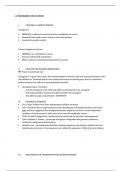Lecture notes
Oncogenes: Tumour Suppressor Genes
- Module
- CANCER BIOLOGY LECTURE NOTES
- Institution
- University Of East Anglia
Tumour Suppressor genes: * Loss of functions * Familial cancer * Tumour Suppressor *NF1,PTEN,APC *Khudson's Two-Hit Hypothesis *FRAUMENI SYNDROME
[Show more]



